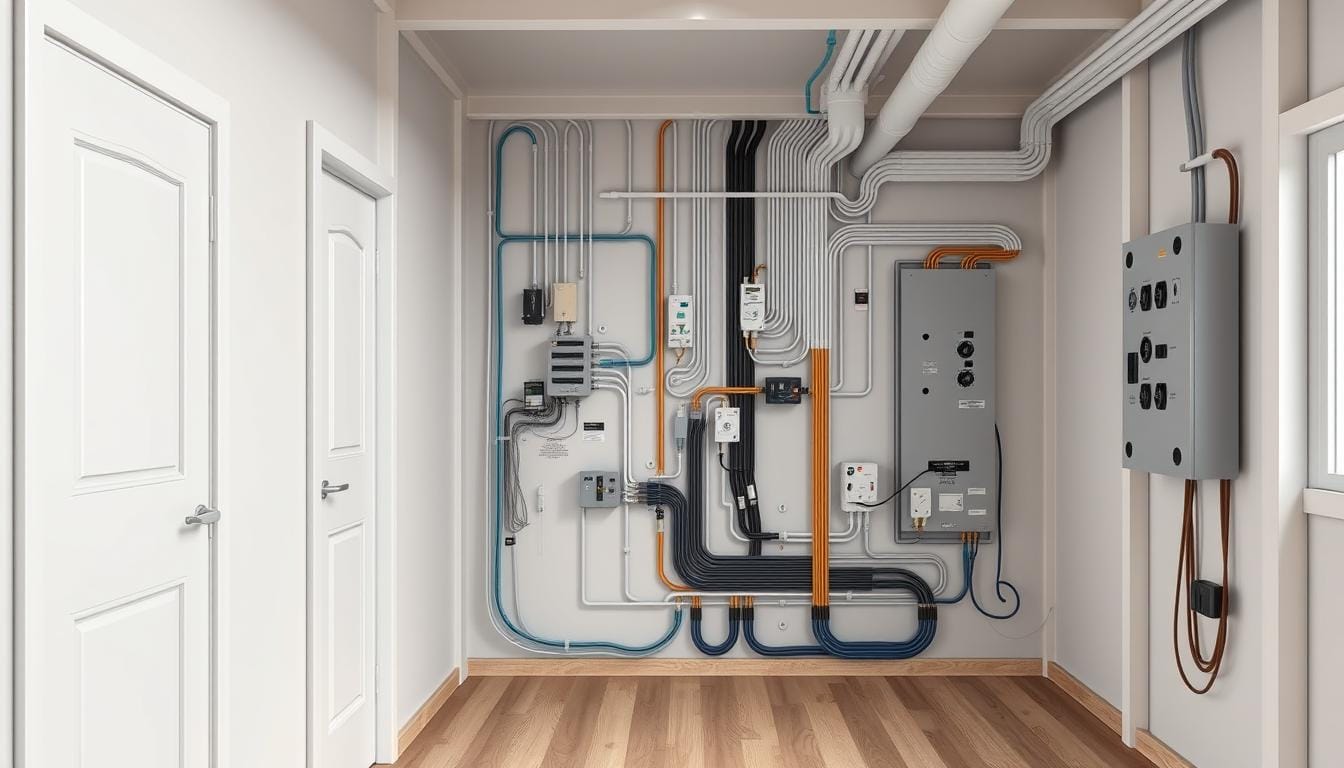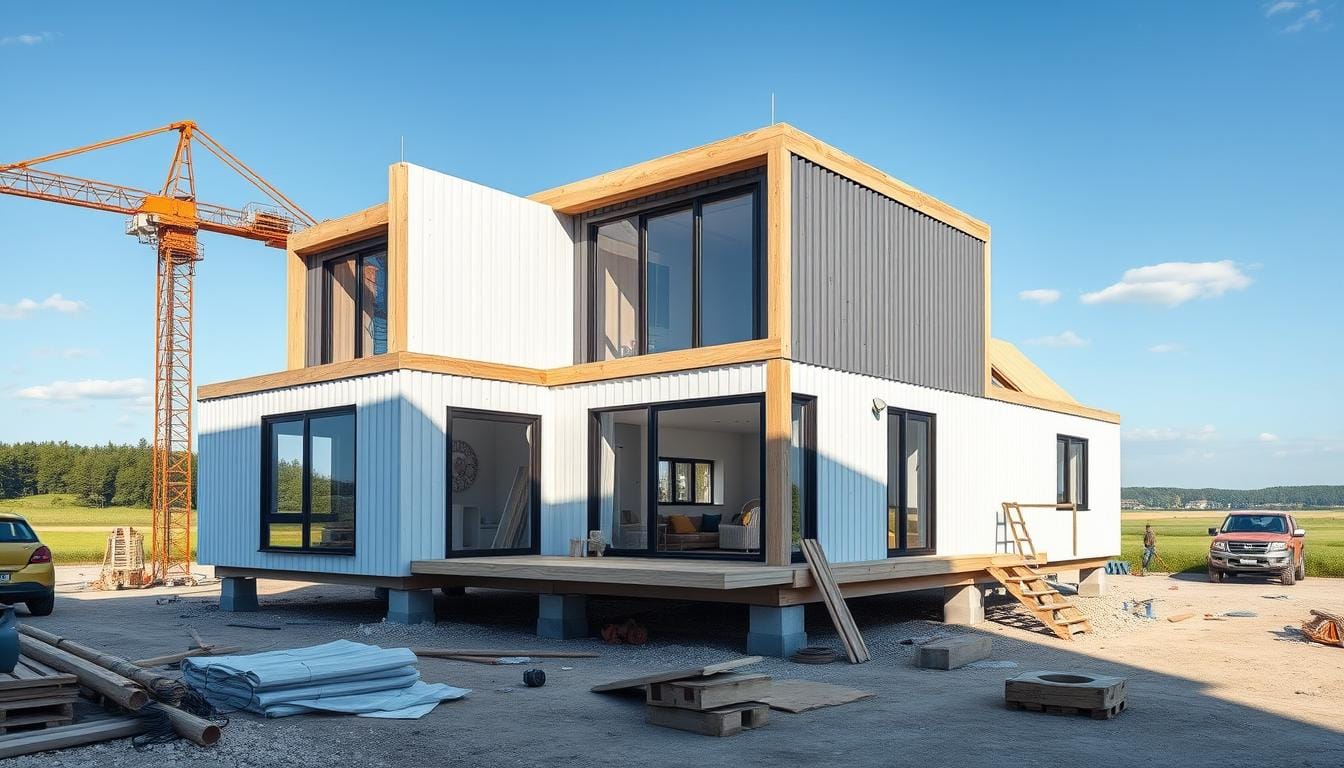Modular home electrical wiring is changing the game in the electrical world. It brings new, efficient ways to match today’s trends, like using renewable energy. These systems are made before they arrive, which means less work on-site.
This method saves time and money. It also makes homes safer and follows the latest rules.
Unlike old wiring methods, modular systems are simpler. They cut down on risks and make work more efficient. They’re made for homes built in parts, ensuring they’re safe and meet all the rules.
They use the latest tech, giving homeowners a reliable electrical setup. This is why more people are choosing modular homes.
Key Takeaways
- Modular home electrical wiring significantly reduces installation time by up to 70%.
- The pre-assembled nature of modular systems minimises on-site adjustments and risks.
- These wiring systems ensure compliance with BS 7671 and other relevant standards.
- Modular wiring solutions are cost-effective, reducing the need for multiple skilled electricians.
- Reliability is a key advantage, with installations working correctly first time after connection.
Understanding Modular Home Electrical Systems
Modular home electrical systems are designed to be efficient and reliable. They use pre-built modules with all electrical components. These systems follow the National Electrical Code (NEC) for safety.
The wiring is done before the interior and exterior drywall. This is based on the home’s layout design.

Overview of Electrical Systems in Modular Homes
In modular homes, electrical systems are integrated for efficiency and safety. Outlets are usually 120 volts, but some appliances need 220- or 240-volt outlets. Different electrical boxes serve different purposes, like junction boxes for wire splices.
Non-metallic wires are used to reduce fire risk and overheating. The main electrical panel distributes current to all appliances and switches in the home.
It’s important to use a certified electrician for electrical installation. Arc Angel Electric, with over 17,000 serviced customers, ensures safe and efficient installation.
Advantages of Modular Wiring Solutions
Modular wiring solutions offer many benefits, including efficiency and safety. They significantly reduce installation time. Panel Built’s modular wiring systems can cut installation time by up to 70%.
This quick installation also reduces labour costs. Modular wiring is cost-effective because of its plug-in and connect setup. This setup simplifies deployment and reduces the need for extensive professional intervention.
Modular systems also offer flexibility for future changes. They are ideal for the adaptable nature of modular homes. With UL certified and tested systems, modular wiring ensures consistency and safety.
For those interested in designing their own modular home, visit Prefab Market for more information.
Key Components of Modular Electrical Wiring
Understanding the parts of modular home electrical wiring is key for safe and efficient use. These systems are better than old wiring methods. They are the top choice for many.

Main Electrical Panel
The main electrical panel is the heart of a modular home’s electrical system. It’s vital for spreading power to different parts of the home. Thanks to modular wiring rules, this panel is ready-made and tested before it’s installed. This saves time and reduces mistakes.
The panel’s design fits well with other electrical parts. It makes the system reliable and easy to use.
Circuit Breakers and Fuses
Safety is a big deal in building modular homes. Circuit breakers and fuses are key to keeping the electrical system safe. They stop overloads and short circuits, following strict wiring rules.
Using standard parts helps avoid mistakes during setup. These components keep the electrical system safe. They prevent dangers and expensive damage.
Wiring Types Used
The wiring in modular homes is chosen for safety and efficiency. Non-metallic sheathed cables are often used. They have better insulation and are less likely to get damaged.
Modular wiring makes the system safer by standardising it. This lowers the chance of electrical failures. It also makes the system last longer. Pre-assembling and testing these parts in a controlled setting creates a strong and reliable electrical system.
For more on modular home electrical wiring components and rules, check out our detailed guide on modular home parts.
Installation Process for Modular Electrical Wiring
Understanding the installation process for modular home electrical wiring is key for those exploring the modular home movement. The process starts with a well-prepared site and main distribution board. It ensures all initial checks are done efficiently.

Preparing for Installation
Preparation is vital for a smooth modular home electrical system setup. This includes:
- Assessing the site for logistical challenges
- Reviewing blueprints and electrical plans
- Ensuring the main distribution board is set up correctly
Steps in the Wiring Process
After preparation, the wiring installation follows a streamlined path:
- Connecting the main electrical panel: It’s placed securely, ready for integration with other components.
- Installing prefabricated wiring assemblies: Pre-made wiring solutions cut down on labour time and ensure consistency. This step can reduce installation time by up to 70%.
- Integrating outlets and switchgear: Modular assemblies make connections quick and standardised. This avoids snagging issues and keeps safety standards high.
- Finalising connections: Skilled electricians check all connections work perfectly. This ensures the electrical system is efficient and reliable from the start.
The installation process is quick, saving contractors time and money. It also reduces the chance of on-site errors. Real-world examples, like the Olympic Stadium and St Bart’s Hospital, show the reliability and cost-effectiveness of modular wiring solutions.
Safety Considerations and Regulations
The safety of your modular home is very important. Following British Standards is key to ensuring electrical safety. This way, homeowners know their home’s electrical system is safe and meets high standards.

Compliance with British Standards
British Standards are essential for safe electrical systems in modular homes. They make sure all electrical parts and wiring follow safety rules. It’s not just a choice, but a must for safe and reliable homes.
Importance of Professional Installation
Getting a certified electrician to install your home’s electrical system is vital. They know how to handle the complex wiring. This ensures your home meets all safety standards.
- Enhanced safety due to expert handling of sophisticated wiring systems
- Compliance with all local and national electrical codes
- Reduced risk of electrical hazards such as fires and shocks
- Assurance that the electrical system functions as intended, providing reliability
Using advanced manufacturing and professional installation makes your home’s electrical system safe and reliable. Choosing professional services is a smart investment for long-term safety and efficiency.
Maintenance of Electrical Systems in Modular Homes
Keeping your modular home’s wiring in good shape is key to its safety and longevity. Regular checks help spot and fix problems early. This makes your home’s electrical system safer and more reliable.

Regular Inspection Practices
Regular checks are vital for your home’s electrical system. Look at rooms, circuit breakers, and wiring to catch issues before they grow. It’s also important to check grounding receptacles, which have been a safety must for decades.
Read more about electrical system maintenance in modular homes
Troubleshooting Common Electrical Issues
Knowing how to fix common electrical problems is important. Look for signs of damage like overloads and bad connections. Regular checks every 6 to 12 months can help spot these issues.
Every 3 to 5 years, do a more detailed check to make sure everything is safe. Getting a licensed electrician to help with upgrades is also a good idea. They ensure your wiring meets standards and is safe.
Following these tips helps keep your electrical system in top shape. This means a safer home and more peace of mind for you.
Smart Home Integration
Smart home technology is now easier to add to modular homes. This is thanks to the flexible electrical systems in these homes. It brings together convenience, efficiency, and green living.
Smart homes offer advanced features that fit your lifestyle. They make living easier and more enjoyable.
Renewable Energy Solutions
Renewable energy is key for eco-friendly homes. Solar panels are a great example. They provide clean energy and cut down on carbon emissions.
Using these technologies saves money on bills. It also makes homes more energy-efficient.
Smart devices are important for managing energy. Smart thermostats, for example, help control heating and cooling. This reduces energy use.
Smart lights and window treatments also help. They adjust based on who’s home and the light outside. This saves energy too.
Smart homes also offer better security. You can add things like smart cameras and locks. This makes your home safer.
Systems like Apple HomeKit and Samsung SmartThings make controlling devices easy. They keep your home secure and private.
Artificial intelligence and IoT make homes even smarter. AI learns your habits to adjust settings. IoT lets you control your home from anywhere. Smart homes in modular homes are a big step towards better living.




